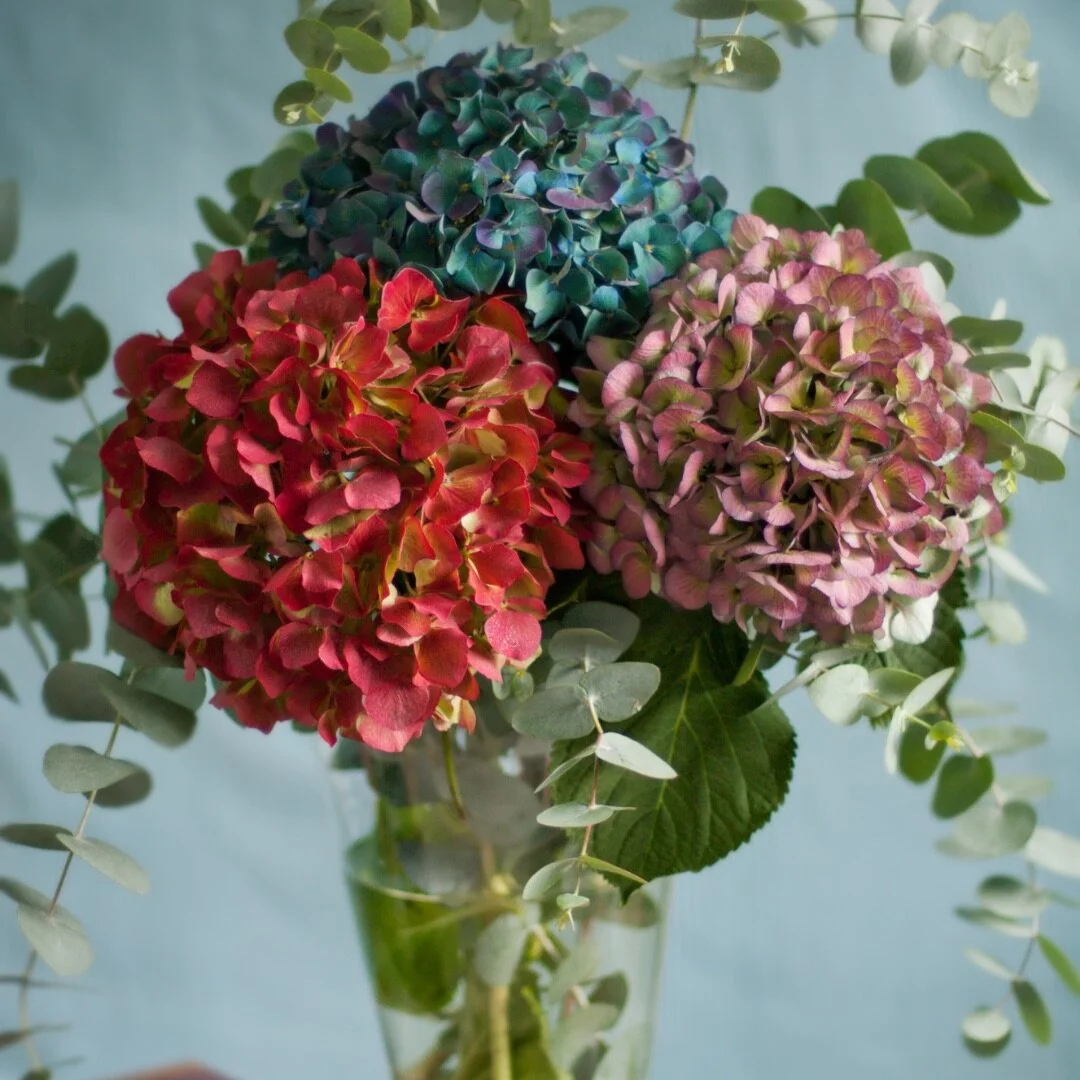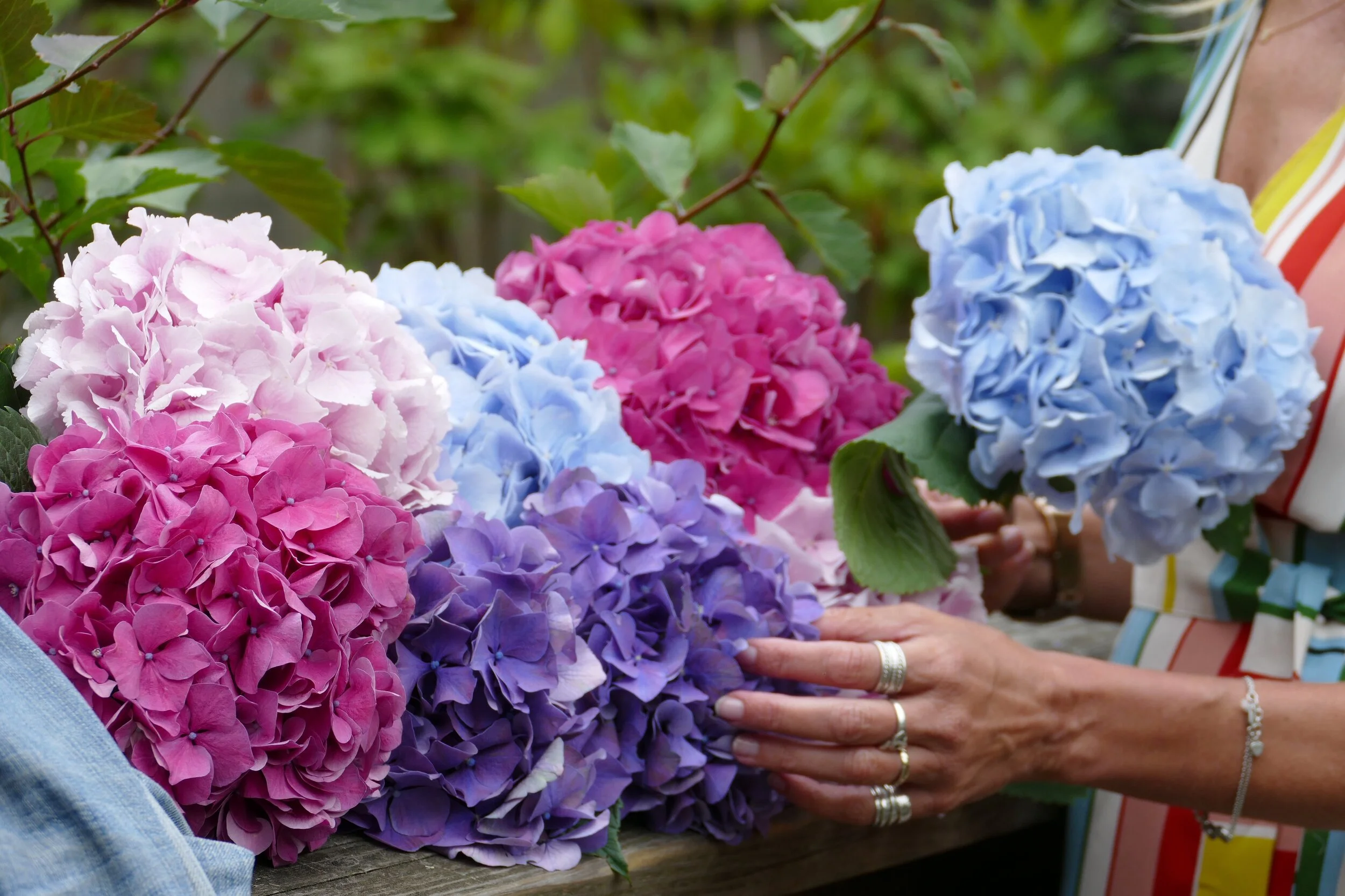Secrets Revealed - Top Tips to Make ‘Tricky’ Flowers Last Longer.
A vase of fresh flowers brightens up any room, but to keep them looking their best they need to be cared for properly. While all flowers require some level of basic care, there are some ‘tricky’ flowers that need a little extra TLC. While this requires a bit more effort on your part, the …
A vase of fresh flowers brightens up any room, but to keep them looking their best they need to be cared for properly. While all flowers require some level of basic care, there are some ‘tricky’ flowers that need a little extra TLC. While this requires a bit more effort on your part, the payoff is worth it.
There are two main things to look at - the bloom and the stem.
Tricky Blooms
Hydrangeas:
Hydrangeas are known for wilting quickly. What’s not as well known is that hydrangeas absorb water through their petals.
If your hydrangea is looking tired, fill a bucket or sink with water. Submerge the whole hydrangea head in the water for 30-60 minutes to rehydrate.
Note: This is only if your hydrangea has wilted prematurely. This will not revive a bloom that is dead.
Lilies:
As lilies bloom they reveal stamens of pollen in their centre. Removing the stamens will lengthen their vase life.
Bonus: Lily pollen stains anything it touches. Removing it will save you from having to deal with a stain on your clothes later on.
Roses:
When you first get your roses, if the outer petals seem wilted and a bit black around the edge, don’t worry. Growers leave these petals on to protect the inner part of the rose during travel. Just remove the outer layer of petals to allow the rose to bloom.
Note: When you buy your roses check the base of the bloom. If one layer has been removed, no problem, that was the guard petals. If many layers have been removed, don’t buy. If someone has removed multiple layers they’re trying to hide the fact the rose is old.
Tulips:
You bring some tulips home, put them in a vase and they’re standing straight and tall. The next morning the stems are curving and bending. What went wrong? Actually nothing. There are two scientific reasons why this happens. One, tulips continue to grow after they are cut and two, they’re attracted to light, so they’ll reach in that direction.
If you want your tulips to be straight, use a tall vase to give the stems extra support and turn the vase a quarter rotation daily.
Note: Or, you could just embrace the tulips movement and enjoy the uniqueness this flower has to offer.
Tricky Stems
Woody stems:
Woody stemmed flowers: Hydrangea, roses, lilac, heather, pussy willow
You may have heard you should smash the end of woody stems in order to help them absorb water. This is actually the wrong thing to do. Smashing the stems will increase the amount of bacteria in the water and shorten the vase life of the flower.
Instead, after cutting the end of the stem at a 45-degree angle, create an additional 2 inch cut up through the length of the stem.
Hollow stems:
Hollow stemmed flowers: Bells-of-Ireland, amaryllis, delphinium, lupins
The trick to getting hollow stemmed flowers to last longer is to fill the stem with water.
Remove any foliage off the stem; Cut the end at a 45-degree angle; turn stem upside down under a running tap to fill with water; hold thumb over the stem until it’s placed in a vase of water. The flower now has a whole stem full of water to drink from.
“Sap’ dripping stems:
Sap dripping flowers: Daffodils, tweedia, poinsettias
When you cut the stems of these flowers, a milky sap seeps out. This sap in the water clogs other flowers from absorbing water. There are two methods you can use to prevent this from happening. 1 - Cut the stem and immediately dip it in boiling water for 30 seconds; 2 - Light a candle and hold the end of the flower stem in the flame for a few seconds. Both will seal the end of the stem so they can then be placed into the vase of water.
If you follow these tips you’ll have ensured your flowers are in the best possible condition to give them the maximum amount of vase-life possible.
If you know of any other ‘secret’ tips, you’d like to share, please put them in the comments below.
Nine Flowers and Facts you may be Surprised to Learn
We all love flowers. They’re a gift to us from nature, that we re-gift by giving to others. They’re beautiful and colourful, and fragrant, and they put a smile on our face. They’re also really interesting! I’ve chosen nine flowers to share some fun facts about.
1 - Sunflowers: Young sunflowers move throughout the day, following the sun from east to west. Why does this happen? It has to do with the growth of the sunflowers. It’s a result of …
The colour of a hydrangea is determined by the type of soil it’s grown in.
We all love flowers. They’re a gift to us from nature, that we re-gift by giving to others. They’re beautiful and colourful, and fragrant, and they put a smile on our face. They’re also really interesting! I’ve chosen nine flowers to share some fun facts about them.
1 - Sunflowers: Young sunflowers move throughout the day, following the sun from east to west. Why does this happen? It has to do with the growth of the sunflowers. It’s a result of different sides of the stem, growing at different times of the day. The side of the stem facing east grows quickly during the day, and the side facing west grows quickly at night. Thus they move from east to west, following the direction of the sun. Once the sunflowers are mature, their growth slows down and they gradually stop tracking the sun altogether.
2 - Roses: Roses are related to many herbs and trees that include edible fruits. The rose family is called ‘rosaceae’. Included in this are a number of trees: apple, pear, peach, nectarine, plum, cherry, and almond, as well as berries including raspberries and strawberries. If you look closely at these trees and bushes when they’re flowering, you’ll see the similarities between them all.
3 - Tulips: At one point in history, tulips were more valuable than gold. In Holland in the 17th century, tulip bulbs became so desirable they could cost more than ten times an annual middle-class income. That crazy time became known as ‘Tulip Mania’. Eventually, the tulip market crashed, and while they no longer have the same monetary value, they’re still one of the most popular springtime flowers.
4 - Chocolate Cosmos: This flower actually smells like chocolate. It’s true! This delicate bloom actually smells like chocolate (and the colour actually looks like a red velvet cake). But while it smells like chocolate, don’t be tempted to eat it as it’s not an edible flower.
5 - Gerberas: Gerberas help you get a good night’s sleep. Gerba’s are so bright and cheerful looking you don’t think of them as a ‘restful’ flower. But because they release small amounts of oxygen throughout the night, they make a great flower to have next to your bed.
6 - Hydrangeas: The colour of a hydrangea is determined by the type of soil it is grown in. The acidity level of the soil is what determines if you will have a blue, pink, or purple bloom. If the soil has a higher pH level, the hydrangeas will be pink. As the pH level gets lower they will become purple or blue.
7 - Daffodils: Daffodils are used as currency. On the island of Scilly, as rent for his lands, Prince Charles is paid one daffodil! (That would be a nice rent to have to pay.)
8 - Lilies: You can extend the vase life of lilies with one simple act. Fresh cut lilies can last up to two weeks. But you can extend their vase life even further by removing the pollen from the centre of the flower. When each bloom opens, carefully remove the pollen off the stamen. Be careful to not get any pollen dust on the petals as it will eat away at the flower shortening its life span.
9 - Daisies: How did the daisy get its name? One theory is related to its physical appearance. It’s said the yellow centre of the daisy resembles the sun. That was known as ‘the day’s eye’. Eventually, that just morphed into ‘daisy’.
Before I started researching for this post, I knew some of these facts but didn’t know all of the explanations. Others were completely new to me. What did you learn?
(I’m now working on another post with uncommon facts related to edible flowers.)




